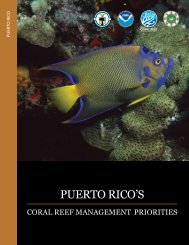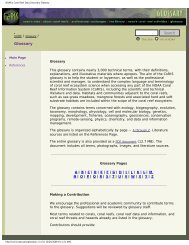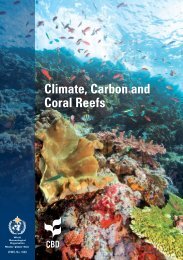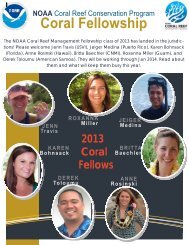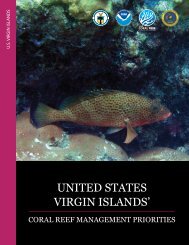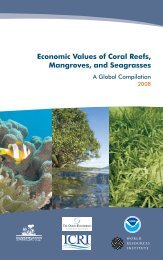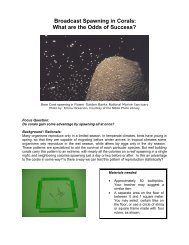Deep-Sea Coral Collection Protocols - NOAA's Coral Reef ...
Deep-Sea Coral Collection Protocols - NOAA's Coral Reef ...
Deep-Sea Coral Collection Protocols - NOAA's Coral Reef ...
- No tags were found...
You also want an ePaper? Increase the reach of your titles
YUMPU automatically turns print PDFs into web optimized ePapers that Google loves.
Reproduction in deep-sea colonial coralsby Sandra BrookeAs coastal species become more depleted, increased effort will be displaced into deep-sea fisheries,which pose the greatest threat to deep-sea coral habitats. Recovery of a damaged ecosystem isdependent on the ability of the keystone species to re-colonize affected areas. <strong>Coral</strong>s can do this viaasexual fragmentation, which can clearly be seen in deepwater coral habitats, but the effectiveness ofthis mechanism is limited, because fragments cannot travel far from the parent colony. Although colonygrowth and fragmentation can compensate for local small-scale damage, re-colonization of large areasrequires larval recruitment, which is determined by larval lifespan and behavior, local currents, and postlarvalsurvival. Knowledge of reproductive strategy, fecundity, and larval biology will enable us to assessthe potential of deep-sea corals to recover from natural and anthropogenic impacts.Scleractinians do not have true reproductive organs;eggs and sperm develop within the acellular mesogleallayer of the mesenteries (Fig. 16). Gamete developmentbegins when primordial germ cells, appear within themesenterial gastrodermis (Szmant-Froelich et al. 1980,1985, Delvoye 1982, Wyers 1985). These cellsproliferate and migrate from the gastrodermis into themesogloea of the mesenteries, where they undergomeiosis to form primary oocytes. As oocytedevelopment proceeds, yolk is laid down and thecytoplasmic volume increases (Fig. 16). Male germcells originate in the same way as females. Primordialgerm cells enter the mesogloea from the gastrodermis, Fig. 15. Living polyps of Lophelia pertusathe spermatogonia then differentiate into primary spermatocytes, which undergo meiosis to formsecondary spermatocytes then spermatids (Delvoye 1982). Mature gametes are released through themouth, (spawning cues are unknown), and embryogenesis and larval development take place in thewater column.A study of reproduction in deep-sea corals from New Zealand showed that four colonial species,Enallopsammia rostrata, Goniocorella dumosa, Madrepora oculata and Solenosmilia variabiliswere all gonochoristic: each colony was either male or female. Broadcast spawning was the probablemode of reproduction, with spawning inferred in all species for late April or May. There was a high levelof synchrony between species in the seamount localities studied. High fecundities were estimated for E.rostrata (>144 oocytes per polyp), G. dumosa (>480 oocytes per polyp) and S. variabilis (>290oocytes per polyp), with a negative correlation between oocyte size and fecundity for all three species(S. Burgess, pers .comm.).Oculina varicosa is a gonochoristic broadcast-spawning species with an annual reproductive cycle.Gametogenesis begins in early spring and terminates in a protracted spawning season that lasts from lateJuly until early September. Fecundity level varies from ~2000-5000 oocytes per cm 2 of skeletal surfacearea. There is evidence for male-induced spawning in females, but again, information regarding13





